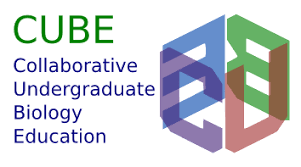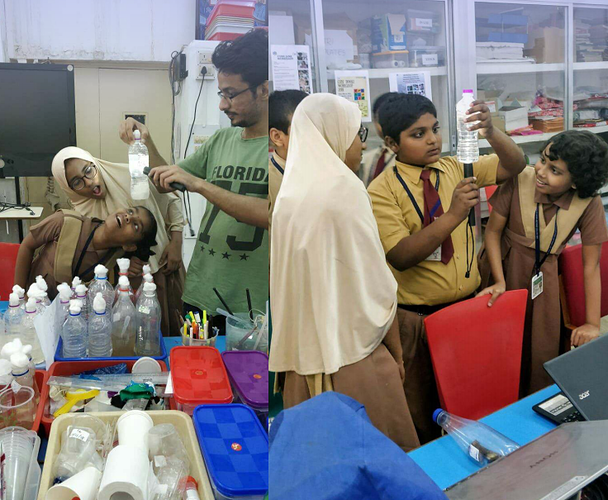- Collaboratively Understanding Biology Education
- History of CUBE
- The CUBE Design rationale
- Open Issues
- Projects
Collaboratively Understanding Biology Education

CUBE: Collaboratively Understanding Biology Education, is currently, in the 8th year of operation, this project expanded in its scale and continued to encourage and inspire us. As a demonstration of the pedagogical principles designed as a part of the gnowledge lab, CUBE initiative stands out as one of our major integrated initiatives, that has multiple implications to STEM education in the country.

History of CUBE
The CUBE project started as a 5-week hands-on research experience based on ‘Simple Model Systems’ like daphnia, Drosophila, snails, in the summer of 2012. The first phase saw the participation of only 18 students from 4 different colleges in Mumbai. Working on these simple model systems, the participants engaged in some frontline questions regarding the molecular basis of learning and memory, epigenetics, regeneration, decision-making, biological rhythms, etc. What happened next is more unconventional as this model of undergraduate research proved to be beyond ‘apprenticeship model’ wherein students are trained in a one-time workshop. It showed cascade effect as more and more colleges continued to be roped in as participating colleges and required them to establish ‘simple model systems’ based research labs in their colleges and initiate neighborhood colleges into already expanding CUB research program. These student-centered frugal research labs showed open-ended, interactive, inquiry-driven, collaborative and context-bound biology research undertaken by these students. The model systems and the techniques introduced in these labs are incredibly inexpensive and yet raise sophisticated questions and initiated students into the broader scientific practice wherein they engaged in frontline questions through these simple model systems.
For any such collaborative learning environment to sustain, the importance of change agents, which are teachers in our cases, cannot be undermined. Hence, it is pertinent that the gap between the teachers and researchers be bridged by linking the two in ways that bring processes of research into teaching and also help teachers build their research profile. We tried to do this through various teacher-training interventions. CUBE model of learning is thus built on ‘communities of practice’ model where teachers, researchers, and students are socialized into the practice of research communities through active and sustained engagement and collaboration.
Besides face to face interactions in CUBE labs, our virtual platforms like social networking apps and our platform provide a networked learning environment which enables learners to get entry into a common database that can be browsed, retrieved, linked and commented on by users for information on various model systems. Simultaneously, the learners provide and receive process-related feedback which effectively guides the continued revision and restructuring of knowledge.
The result of all these painstaking efforts has been extremely rewarding. Besides students learning in these labs and opening such labs in their colleges, for instance, BehaviorWatch and Drosophila were included as a model system in Mumbai University Zoology practical syllabus. Likewise, Delhi University awarded the taxonomic profiling of motor actions of birds as an innovation project by supporting ten undergraduate students as a part of the CUBE.
The CUBE Design rationale
The rapidly advancing frontiers of biology research and the changing nature of biology resulting from it, have called for some serious action to be taken to transform the nature of biology education. The undergraduates need to be prepared for the challenges posed by the changing ways we think about and engage in biological research, while opportunities for investigating questions, which otherwise could never be addressed, are becoming possible due to emerging technologies. There is a strong need first to accept and subsequently ensure that the biology we teach authentically reflects the biology we do. The 21st-century biology undergraduate needs to engage in authentic biology research and integrate the research experiences and skills acquired into understanding, solving and making informed decisions on complex problems related to biology and those encountered in their daily lives.
The 21st-century biology requires that undergraduates learn to integrate concepts across levels of organization and complexity and that they synthesize and analyze information that connects conceptual domains. Teachers, educators, researchers, and curriculum planners need to view teaching from an approach that captures the spirit of the nature of scientific practice and to look for concepts that communicate to each other because it would make more sense to communicate the generalities and encourage students to discover their applications through well-designed laboratory exercises.
The challenge, however, is to keep the undergraduate classroom current and dynamic without making it overwhelming; to excite undergraduates with the modern, cutting-edge discoveries and at the same time finding the right balance between the depth of coverage required for conceptual understanding and the factual knowledge needed for the same. This may need a restructuring of the current undergraduate biology syllabus in many ways. One of the productive ways to strike this balance is to revamp the undergraduate biology by integrating research with teaching; making undergraduate research a meaning-making experience.
To inspire and further solidify the interest of undergraduate biology students in making career choices in biology they should be given an opportunity to experience the allure of the research scholarship. Their participation in such pursuit will improve not only their ability to understand how biologists conduct research but will also prepare them to evaluate scientific claims in their day-to-day lives. This rightly falls under the mandate of “The Vision and Change: Call for Action” report, which discusses the need to develop biological literacy to prepare the coming generation of biology scientists, educators, and informed citizens.
Hands-on research cultivates scientific thinking, giving students authentic research experiences including designing experiments, interpreting unexpected outcomes, coping with experimental failures, considering alternative methodology, testing new techniques and many more. These experiences go beyond the apprenticeship model, and such outcomes can never be expected to be a part of a regular college laboratory.
The undergraduate biology research environment thus forms a rich learning ecology with student-centric features. The typical features of such an ecology are that it is open-ended, interactive, inquiry-driven, cooperative, collaborative, and context-bound. Without any doubt, the research experience will have high levels of student-student and student-faculty interactions, ready connections of the subject matter to topics of student interest and relevance, learning that reflects aspects of scientific inquiry and most importantly learning progressions designed from the efforts of an ongoing students feedback to the teacher as well as their peers. The features of such an ecology mimic those of the actual scientific practices and show developmental progressions in students understanding close to that of the scientists in a typical research laboratory setup.
Linking teaching and research will help to bring the processes of research into teaching and can support students in the development of a variety of specific as well as general skills. It can also benefit institutions to build a research profile and thus encourage networking with other institutions and research groups. Further, a community of biology educators/researchers will be built, who are willing to integrate evidence-based practice into their teaching. Platforms like an online portal will provide an overview of the pedagogic practices and the reasons for adopting a particular practice.
It is critical that the mutually synergistic communities of biology teachers/educators and biology researchers work together to meet the common goal of student-centered learning. We have been using these principles in other projects like Connected Learning Initiative (ClIxx), makerSpace and STEMGames.
Open Issues
Several open issues have emerged from our 6-year long engagement with students in our CUBE research programs. For instance, analyzing and examining:
- role of connected learning environments, using new media, instant messaging in learning and knowledge generation in a group of students
- the strength of the weak links in causing, propagating and maintaining networks of participants students engagement with inscriptions, pictures, graphs in communication in lab and causeries or formal meetings held in CUBE lab
- role of multi-graded classroom/laboratory in bringing dynamism in research fostering learning environment like CUBE
- Students’ misconceptions regarding sciences, ways of doing science, especially biology
- group dynamics that give rise to learning in a group of participants
- negligible participation of teachers in the program
Projects
Here are the projects - STEM Investigation Projects - CUBE